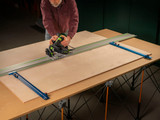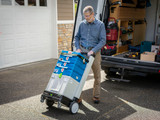The Differences Between Parallel Guides and Rail Squares
Accurate and repeatable cuts are vital to precision woodworking, and adding the right accessories to your repertoire can make your quest for accurate results that much easier. In this article, we’ll discuss guide rail squares and parallel guides and the difference between the two products.
Over the years, using track saws has become more common for woodworkers. Track saws speed up the process of cutting down sheet goods but also have the precision to make glue-line-ready joints (when properly calibrated). While the track saw itself is an incredible tool, further efficiency can be unlocked by adding the right accessories.
For track saw “converts,” two of the most common accessories tend to be guide rail squares and parallel guides. One provides accurate cuts; the other provides repeatability. And they both save you time. Deepen your understanding of the differences between parallel guides and rail squares.
What Are Parallel Guides?
Parallel guides usually utilize two equal-length tracks with adjustable parallel stops to ensure that the guide rail cutting edge is an equal distance from the opposite cutting edge. By setting both stops to the same length, you’re guaranteed a parallel cut. In most cases, doing this requires two equal-length tracks that are adjustable in size.
Parallel guide systems attach to the track saw guide rail using a variety of different methods, though the best products tend to be fast to attach and eliminate any potential for slop. Simply place the guide rail at the approximate cutting position atop your workpiece, and slide (or drop, depending on the model) your parallel guides to your guide rail. Secure the parallel guide to the guide rail using grub screws, knobs, or whatever clamping method is provided.
Position the stops at the desired rip width you require, and clamp them down. Finally, slide your workpiece under the parallel guides so the left edge of the workpiece contacts each parallel guide stop. Assuming the parallel guide system has been properly calibrated, you’re now ready to start making repeatable cuts. After your first workpiece is cut, simply remove it from underneath the parallel guides and insert the next workpiece, again pushing the workpiece up against the material stops. This ensures your cutting line is identical from workpiece to workpiece.
What Are Guide Rail Squares?
Like parallel guides, guide rail squares are clamped or attached to your track saw guide rail and provide a straight edge perpendicular to your guide rail cutting edge. Guide rail squares excel at enabling you to rapidly make perfectly square cuts with your track saw, referencing the front or back edge of your workpiece But guide rail squares typically won’t ensure a parallel cut, especially on longer rips. However, you can combine guide rail squares and parallel guides. Tools such as the GRS-16 guide rail square can connect to parrel guides to ensure you get square, parallel cuts in a single operation, further speeding up your work.
In summary, while a guide rail ensures every cut you make is square, it shouldn’t be your first choice if you need to create multiple rips of the same panel. Unlike parallel guides, guide rails don’t feature a flip stop, so they won’t replicate an identical rip several times. Rail squares are your best option when you need highly accurate, square cuts.
How Are They Similar?
We’ve talked a lot about the differences between parallel guides and rail squares, but there are also several similarities. With either of these tools, you won’t have to draw multiple marks or a complete line. Instead, you’ll typically place a small mark somewhere along the cutting line, and then make your cut.
Buying Parallel Guides and Guide Rail Squares
With products like guide rail squares and parallel guides, accuracy matters. TSO is a leader in the design, manufacturing, and support of these products, as well as other top-quality woodworking essentials for industry professionals.
Recent Posts
-
What Size Guide Rail Do I Need? Choosing the Right Length (and When to Use Extensions)
The scenario: you need to make a cut in that full size plywood panel sitting in the corner of your s …6th Nov 2025 -
Best Track Saw Systems: Expert Review & Advice
The track saw market has changed considerably over the past three years. Back then, your options wer …6th Nov 2025 -
Systainer Storage Guide: Organize Your Workshop Tools
Picture this: you're setting up for what should be a straightforward series of cuts, but you can't l …2nd Sep 2025




